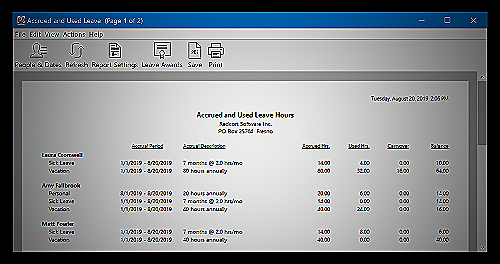Leave Accrued Meaning Update 2023
Leave accrual is the process of accumulating paid time off (PTO), sick leave, and vacation days, which employees are entitled to use after a certain period of employment. It is crucial for both employees and employers to keep track of leave accrual as it ensures that employees are compensated for their unused leave time and that employers are compliant with labor laws.
Check out this Youtube video to learn about the intricacies of long service leave and how it affects company accounting. This informative video will give you a comprehensive understanding of leave accrued meaning and its impact on finance.
What is Leave Accrual?
Leave accrual is a process where employees earn leave time off from work for a certain period of time, usually in hours or days, per a company’s employee benefits policy. This earned leave accumulates over time and can be utilized by the employee for whatever purpose they see fit, such as sick leave, vacation time or personal days.
The accrued leave is considered as paid time off but, with the exception of certain jurisdictions or policies, it is commonly not included in the employee’s regular wages.
Employers are responsible for tracking and recording an employee’s leave accruals and ensuring that the employee receives their earned time off. Additionally, they should make their employees aware of the leave policy, how to request time off, and how their leave accrues.
This way, employees can take advantage of their earned leave time while still ensuring that the company’s work output remains steady.
The Benefits of Leave Accrual
Leave accrual is a system wherein an employee earns a certain amount of paid time off, sick leave, or vacation time specified by their employer. The number of hours or days earned is based on the company’s policy and the employee’s tenure.
There are many benefits to leave accrual, both for employees and employers.
For Employees
Leave accrual can significantly benefit employees in a number of ways:
- Time off – Employees can earn paid time off that they can use for sick leave, vacation, or personal days. This allows them to take a break from work and come back rejuvenated and re-energized.
- Peace of Mind – Knowing they have paid time off available can give employees the peace of mind needed to focus on work and avoid distractions. It can also help alleviate stress and anxiety associated with taking time off.
- Retirement benefits – In some cases, if an employee leaves the company with time off they haven’t used, the employer will compensate them in cash. This can be a valuable retirement benefit employees can appreciate.
For Employers
Leave accrual provides benefits for employers as well. Employers can use leave accrual to:
- Retain top talent – When an employer offers a paid time off policy or vacation accrual rate on par with industry standards, they are more likely to attract and retain top talent
- Track Employee Leave – By tracking employees’ leave accrual, managers and HR can quickly determine how much leave a team member has available when they make a time-off request.
- Manage Finances – Employers can plan and manage finances when they have a clear idea of accrued leave for each employee. This helps ensure the company is not left with a financial burden or a large payout when employees leave the company.
In Conclusion
Leave accrual is a useful tool for both employees and employers. For employers, they can manage employee leave more effectively, retaining top talent and manage financial obligations.
For employees, they enjoy paid time off benefits, peace of mind and retirement benefits.
Leave Accrual Policy
A Leave Accrual Policy is a set of guidelines and rules created by an organization to manage their employees leave hours or time‘ leave hours or time-off benefits. It is a way to keep track of the amount of leave time an employee has earned but not yet used.
An effective Leave Accrual Policy eliminates confusion and misunderstandings surrounding employee leave accrual and simplifies the process of requesting time off.
In order to create an effective Leave Accrual Policy, employers should consider the following elements:
- The company’s leave accrual calculation method should be clearly defined and explained in the policy.
- Employee eligibility criteria for leave time accrual.
- How leave hours are earned and credited.
- The maximum number of leave hours an employee can accrue.
- The carryover limit for unused leave time, if allowed.
- Rules for leave requests and approvals.
- A designated point-of-contact for employees to ask questions about their leave accrual status or to request time off.
An effective Leave Accrual Policy recognizes the importance of time off for employees and ensures they are aware of the benefits they are entitled to. It also helps employers manage their responsibilities and maintain accurate records of leave accrual, resulting in a productive and efficient work environment.

Leave Types and Accrual
Employees can accrue different types of leave, including sick leave, vacation leave, and personal leave. Sick leave is typically used for illness and medical appointments, while vacation leave is used for leisure time and personal days.
Personal leave is typically used for bereavement or other personal reasons.
Accrued Leave Meaning
Accrued leave refers to the amount of leave time that an employee earns per their company’s employee benefits policy, but which has not yet been used or paid. It is a liability for the employer.
In simpler terms, it is time off that employees earn as a benefit for working at their company.
Accrual policies vary, but typically offer leave hours for each pay period, quarter, or year of employment. Some employers increase accrued leave time based on how long employees have worked for the company.
For example, employees may earn 40 hours of leave for years 1-3, 80 hours for 4-8 years, and so on. Employers often place caps on the total leave time hours employees can earn, and reset the leave time every year.
When an employee requests time off, it is important for employers to stay up to date on their leave accruals so they can determine how much leave time/hours the employee has available and whether it can accommodate their request. Employees who meet the criteria necessary to receive benefits can use accrued leave hours for vacation or sick time.
Leave Accrual Management
Leave accrual refers to the number of leave hours that employees earn according to the benefits and policies of their employer. It is the amount of leave time earned by an employee, but which has not yet been utilized or paid.
It is important for employers to stay updated on their employee‘s leave accruals for better leave management. This enables the HR team to determine how much leave time is available when an employee requests time off.
Most employers offer a predetermined amount of leave hours as a benefit for working with the company. The leave time offered may increase based on the number of years an employee has worked with the company.
For instance, an employee may be eligible for 40 hours of leave time during the first three years of working with a company and 80 hours for four to eight years of employment. Employers may also have a cap on the total leave time hours that employees can earn.
In such cases, the employer resets the leave time every year.
In order to prevent the annual leave accruals from increasing significantly, companies could offer incentives to employees. This could include running a program for employees to reduce their leave accruals.
Alternatively, companies could leverage their commercial relationships with suppliers to offer employees travel deals or accommodation discounts. Moreover, companies can make the process of annual leave requests as easy and seamless as possible.
Leave Accrual Tax Implications
Leave accrual is taxable income for employees, meaning that it is subject to federal, state, and social security taxes. Employers are also liable to pay unemployment taxes on accrued leave time, as it is considered earned income.
However, employers are not required to withhold taxes on accrued leave time until it is used or paid out.
It is important for employers to accurately track and report accrued leave time, as it is considered a liability on the balance sheet. When an employee takes time off and uses their accrued leave, it becomes an expense for the employer and is tax deductible.
However, if an employee leaves the company and is paid out for their unused leave time, it becomes a taxable expense for the employer.
It is recommended for employers to establish clear policies and procedures for leave accrual and payout to avoid any tax or legal issues. Consult with a tax professional for guidance on managing and reporting accrued leave time.
Common Accrual Issues Employers Face
When it comes to managing employee leave accruals, there are a number of common issues that employers may face. One of the biggest challenges is simply keeping track of employee accruals, especially in situations where different employees may have different accrual rates or policies.
This can be further complicated if employees work part-time or switch between different roles or departments within the organization.
Another issue that employers may face is the risk of employees accruing too much leave over time. If employees are allowed to accrue leave without limits, then an employer may be faced with a significant financial liability if a large number of employees decide to take time off all at once.
To address this issue, employers may need to implement policies limiting the amount of leave that can be accrued or requiring employees to use their leave time by certain dates.
Yet another issue is managing employee leave requests. Even when employees have accrued leave time available, there may be situations where it’s difficult to accommodate their requests for time off.
For example, if multiple employees request the same time off or if the employee’s absence would disrupt critical business operations. To address these issues, employers may need to implement policies governing leave requests or work with employees to develop individualized leave plans that meet the needs of both the business and the employee.
In summary, leave accrued meaning is an important consideration for employers to keep in mind. By carefully tracking employee accruals, implementing clear policies, and working with employees to develop individualized leave plans, it’s possible to manage these issues effectively and provide a positive work environment for all employees.

